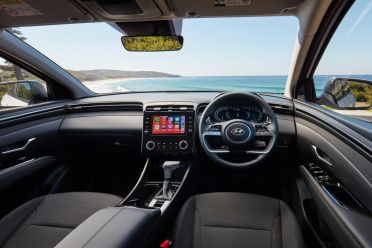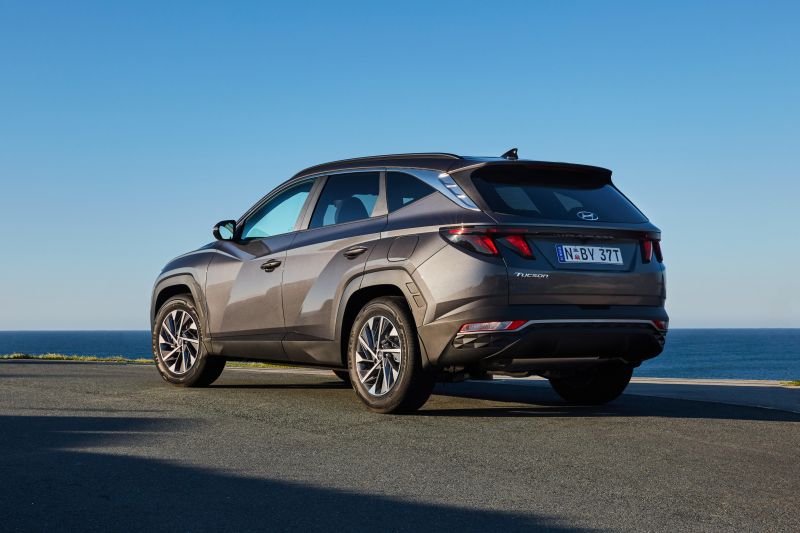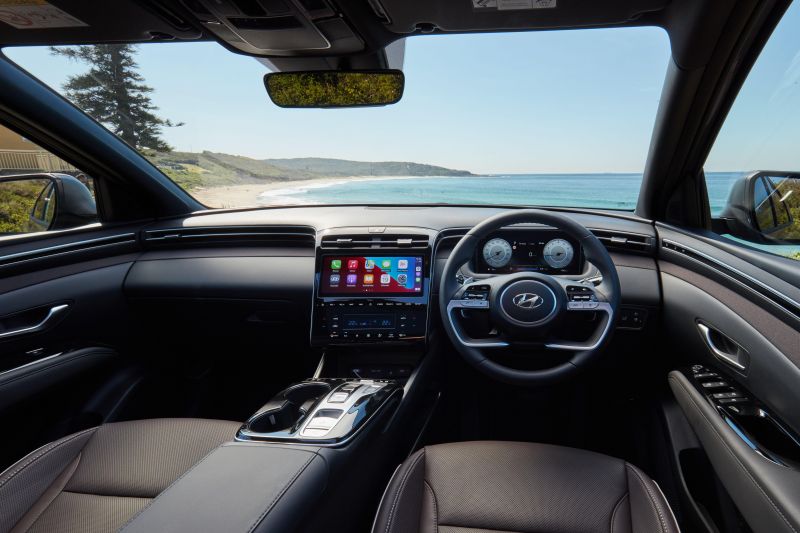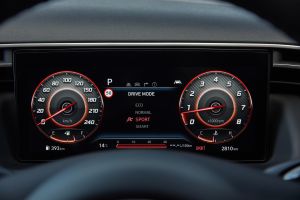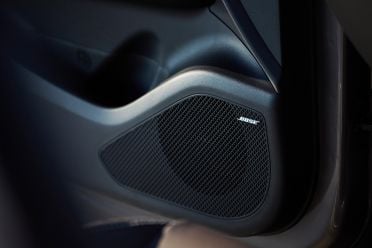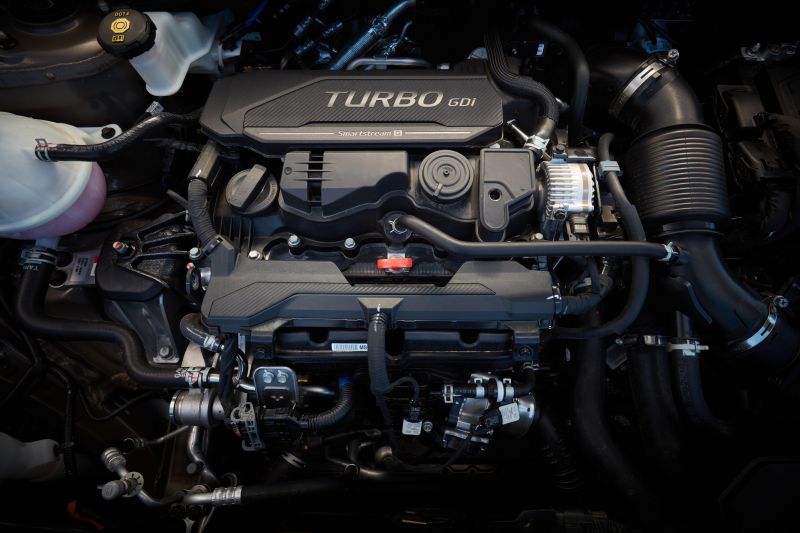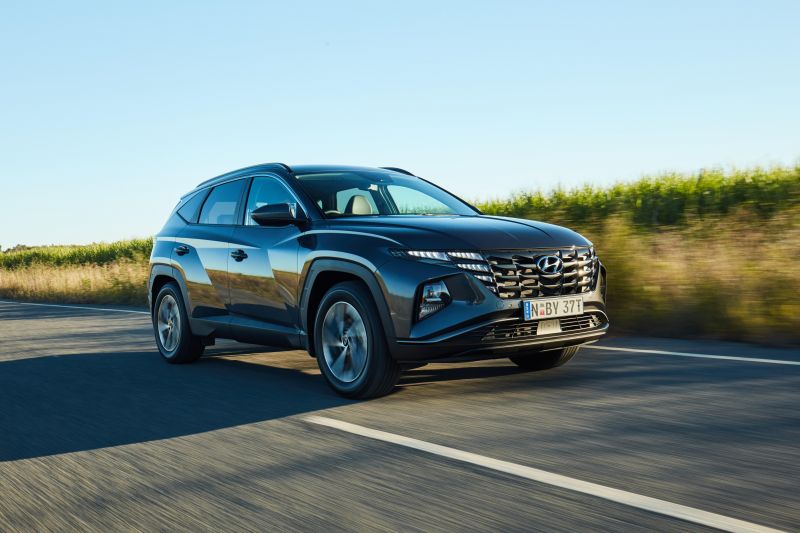The Tucson is all grown up.
Now in its fourth generation, the 2021 Hyundai Tucson – 2022 Tucson if you ask Hyundai – aims to build on the success of its forebears and move upmarket in the uber-competitive medium SUV space.
A lot has changed in 17 years and over 7 million global sales of the Tucson nameplate, and this latest version is bigger, more advanced, and more expensive than ever.
The 2021 Tucson range will undergo a staggered launch in Australia, starting with 2.0-litre petrol front-wheel drive models (on sale now), followed by 1.6-litre turbo petrol all-wheel drive (late Q2 2021) and 2.0-litre turbo-diesel models (Q3 2021).
Later in the year we’ll also see the arrival of sporty N Line models (Q3 2021), essentially offered as an option pack on all trim levels.
Here’s our video from the prototype drive of the 2021 Hyundai Tucson N Line:

How much does the Hyundai Tucson cost?
The 2021 Hyundai Tucson range starts a little over $34,000 and climbs to $53,000, with three core trim levels and three engine variants to choose from – though the base model is only available with the 2.0-litre naturally-aspirated petrol.
All models are also available with the N Line package, which varies in price depending on grade. Front- and all-wheel drive versions are available, again depending on variant.
See the full price list below, with adjustments compared to MY20:
- 2021 Hyundai Tucson 2.0 FWD: $34,500 (+$2360)
- 2021 Hyundai Tucson N Line 2.0 FWD: $38,000 (new)
- 2021 Hyundai Tucson Elite 2.0 FWD: $39,000 (+$800)
- 2021 Hyundai Tucson Elite N Line 2.0 FWD: $41,000 (new)
- 2021 Hyundai Tucson Elite 1.6T AWD: $43,000 (+$1800)
- 2021 Hyundai Tucson Elite N Line 1.6T AWD: $45,000 (new)
- 2021 Hyundai Tucson Elite 2.0D AWD: $45,000 (+$1500)
- 2021 Hyundai Tucson Elite N Line 2.0D AWD: $47,000 (new)
- 2021 Hyundai Tucson Highlander 2.0 FWD: $46,000 (new)
- 2021 Hyundai Tucson Highlander N Line 2.0 FWD: $47,000 (new)
- 2021 Hyundai Tucson Highlander 1.6T AWD: $50,000 (+$3150)
- 2021 Hyundai Tucson Highlander N Line 1.6T AWD: $51,000 (new)
- 2021 Hyundai Tucson Highlander 2.0D AWD: $52,000 (+$2850)
- 2021 Hyundai Tucson Highlander N Line 2.0D AWD: $53,000 (new)
All prices exclude on-road costs.
The 2.0-litre petrol FWD versions of the Hyundai Tucson are arriving in dealers now, with all-paw 1.6-litre turbo petrol and 2.0-litre turbo-diesel models arriving throughout May and June.
N Line versions will commence production for Australia in the coming weeks, scheduled to lob Down Under during the third quarter of 2021.
The Tucson follows numerous competitors in raising prices of late.
With challenging exchange rates, enhanced specification levels and supply chain interruptions, it seems the days of bargain drive-away deals are gone for the majority of mainstream brands.
At the lower end of the range, the base Tucson competes with the Ford Escape FWD ($35,990), Honda CR-V VTi ($34,200), Mitsubishi Outlander ES ($33,490), Nissan X-Trail ST ($32,665), Subaru Forester 2.5i ($35,190), Toyota RAV4 GX ($34,695). All prices are for petrol automatics.
The mid-range Elite (from $39,000) competes with mid- to high-spec versions of the aforementioned competitors, as well as the Volkswagen Tiguan 110TSI Life ($39,690).
At the pointy end of the Tucson line-up, the all-wheel drive Highlander rivals flagship versions of mainstream-branded rivals, but also is priced within range of several premium-badged alternatives.
These include the Audi Q3 40 TFSI quattro ($54,450), BMW X1 sDrive18d ($53,900), Lexus NX300 Luxury 2WD ($57,500), Mercedes-Benz GLA200 ($55,300), and the Volvo XC40 T4 Inscription ($52,990).
MORE: 2021 Hyundai Tucson price and specs
What do you get?
The base Tucson features:
- 8.0-inch touchscreen infotainment system with wireless Android Auto and Apple CarPlay
- 4.2-inch instrument cluster display screen
- 17-inch alloy wheels
- Leather-wrapped steering wheel and shifter
- Autonomous emergency braking with junction assist
- Blind-spot assist
- Lane-keeping assist
- Tyre-pressure monitoring
- Reversing camera with rear parking sensors
- Halogen headlights with LED daytime running lights
- Automatic headlights
- Grey/black cloth upholstery
- Full-size spare wheel
- Remote folding second-row seats
- Driver’s seat power lumbar adjustment
The Tucson Elite adds:
- 10.25-inch navigation system with Android Auto, Apple CarPlay (wired)
- 18-inch alloy wheels
- Power driver’s seat
- Heated front seats
- Dual-zone climate control
- Front parking sensors
- Keyless entry and start
- Black leather upholstery
- Rain-sensing wipers
- Rear privacy glass
- Paddle shifters (excludes 2.0-litre petrol)
- Rear seat occupant alert
The Tucson Highlander adds:
- 10.25-inch digital instrument cluster
- 19-inch alloy wheels
- Parking collision avoidance assist
- Remote smart parking assist (diesel only)
- Bose premium sound system
- Surround-view camera system
- Blind-spot view monitor
- Power tailgate
- Heated and ventilated front seats
- Heated rear seats
- Heated steering wheel
- Power driver’s seat with memory
- Power passenger seat
- LED headlights and tail lights
- Ambient lighting
- Electro-chromatic rear-view mirror
- Passenger walk-in device
- Silver-painted skid plate
- Choice of black, brown or light grey interior colours
Opting for the N Line package available on all grades brings:
- 19-inch alloy wheels
- 10.25-inch digital instrument cluster (Tucson, Elite)
- Sports seats
- LED headlights and tail lights (Tucson, Elite)
- Leather and suede upholstery
- N Line steering wheel
- Black interior with black headliner
- Metal pedals
Notably, the Tucson doesn’t offer a head-up display on any grade – despite the Kona and Santa Fe having one available – while Tucson and Elite grades miss out on LED lighting at both ends.
The latter be addressed, however, by ticking the N Line package available later this year.
Is the Hyundai Tucson safe?
The 2021 Hyundai Tucson hasn’t been crash tested by ANCAP or Euro NCAP. With that said, all models are loaded with Hyundai’s SmartSense safety suite, with some additional premium features offered on higher grades.
Key safety features from the base Tucson up include:
- Autonomous emergency braking with pedestrian/cyclist detection and junction assist (camera + radar)
- Adaptive cruise control with stop/go
- Blind-spot assist
- Rear cross-traffic assist
- Intelligent speed limit assist
- Lane-keep assist
- Lane Follow Assist (lane centring)
- Reversing camera with rear parking sensors
- Leading vehicle departure alert
- Safe Exit Assist
- Tyre pressure monitor
- 7 airbags including front-centre airbag
Features available on higher grades include a more advanced rear seat alert (Elite), front parking sensors (Elite), the Blind Spot View Monitor camera system (Highlander), parking collision avoidance assist (Highlander), a 360-degree camera system (Highlander), and Remote Smart Park Assist (Highlander Diesel).
Given the extensive suite of standard safety features and inclusion of a front-centre airbag, we’d be surprised if the Tucson didn’t achieve a five-star rating. Stay tuned.
What is the Hyundai Tucson like on the inside?
We sampled the Tucson, Elite and Highlander grades on the Australian launch (N Line arriving in Q3 2021), and even though there’s notable differences in the trimmings and features offered the cabin of the new-generation SUV is a much nicer place to be.
The old Hyundai Tucson was a little dreary and dated, and the ambience didn’t feel super upmarket even in the higher grades – this new one is a big step up.
Regardless of the variant you choose, you get a wonderful wraparound cockpit design with ‘waterfall’ centre stack housing an 8.0-inch touchscreen in base models and a 10.25-inch widescreen in Elite and Highlander grades.
Ahead of the driver is Hyundai’s quirky four-spoke leather multifunction steering wheel, and in Highlander grades you get the new 10.25-inch digital instrument cluster as well. Tucson and Elite versions can get this with the N Line package.
Overall ambience and perceived quality is not only much better than its predecessor, but also up there with some of the best in class. All the touch points are trimmed in padded or leatherette surfaces and the tactility of the smooth leather on the steering wheel and shifter is top notch.
The fabric trim in the base Tucson is supple and super comfy to sit in, while the perforated leather in Elite and Highlander grades isn’t quite nappa grade but it’s smooth and relatively soft. Highlander models also get the choice of black, brown and grey trim which is a nice touch.
Hyundai’s latest infotainment software powers both the 8.0-inch and 10.25-inch displays, though only the base unit offers wireless smartphone mirroring. The larger display gets wired Apple CarPlay and Android Auto as well as inbuilt maps – Hyundai and Kia have previously said this is a result of a conflict with the tech giants around priority mapping systems.
Regardless of which screen you get, both have good brightness and crisp resolutions, particularly the 10.25-inch unit. We were running Google Maps on Apple CarPlay for the drive leg from Orange, NSW to Sydney and the quality and definition of the ‘satellite’ map view was stunning.
The processing is snappy, offering quick responses and smooth animations. It’s a user-friendly interface meaning tech heads and their grandparents shouldn’t have too much trouble navigating through functions and sub-menus.
Space and storage is pretty good up front, with comfortable and supportive seats that offer good adjustment in all grades – manual in Tucson, electric in Elite and Highlander – as well as reach and rake adjustment for the steering wheel.
Under the centre stack is a place to store your phone with wireless charger, as well as a small cubby for your keys and/or wallet, while there’s two large-ish cupholders in the centre console alongside the shifter.
There’s also a large storage bin under the front-centre armrest, though as we’ve found in various Hyundai/Kia models sitting on this latest platform, the door bins are too skinny and don’t fit larger bottles which is disappointing for a family-focused vehicle.
Not everyone is going to love the touch-capacitive buttons on the centre stack, which may be a little fiddly to use when you’re on the move – and the gloss black finish of the fascia is a fingerprint magnet. They’re all clearly labelled, though unlike the annoying touch sliders used by some new Volkswagen models.
Moving into the second row, the extended wheelbase of this latest generation has afforded significantly more space for rear occupants than the outgoing model.
I’m a little over six-foot-one and can comfortably fit behind my own driving position with plenty of knee and legroom. Headroom is also excellent.
Two full-sized adults have more than enough space, and you could probably fit three across over short journeys. Parents of little tackers will make use of the outboard ISOFIX mounts and top-tether points, and there’s a fold-down centre armrest with cupholders in the middle.
Behind the centre console there’s also air vents and two USB-A charge points, and the Highlander has rear-accessible powered controls for the front passenger seat so you can liberate even more space with no one in the front seat. Rounding out the rear-seat amenities are map pockets on the front seatbacks and bottle holders in the doors.
The new Tucson’s boot measures a healthy 539L in five-seat configuration and a massive 1860L with the rear seats folded (VDA). Funnily enough that’s almost on par with the larger Santa Fe, which quotes 571L/1649L – not bad.
All models also feature a full-sized spare wheel under the boot floor, which is increasingly becoming a rarity across most segments. Props to Hyundai.
What’s under the bonnet?
For 2021 the Tucson’s powertrains are essentially carried over, though all three motors have been updated with some new technologies to improve efficiency and performance
The standard engine offered across all grades is a 2.0-litre ‘MPi’ naturally-aspirated four-cylinder petrol with 115kW of power (6200rpm) and 192Nm of torque (4500rpm). A six-speed auto and front-wheel drive are standard, no more manual.
Updates for the 2.0 ‘MPi’ motor include a new electronically-controlled continuously-variable oil pump, which Hyundai says helps to improve fuel efficiency. It has also moved to multi-point injection rather than the old ‘GDi’ motor’s direct injection, with outputs down by 7kW and 13Nm respectively.
The claimed fuel consumption is rated at 8.1L/100km, slightly up on the previous generation’s 2.0 GDi petrol (7.9L/100km), but as we found on the launch drive the real-world efficiency of this engine is far better than the outgoing unit – we saw high sixes on the freeway-biased leg, and low to mid-sevens on winding country B-roads.
While not available to drive on the launch, the Elite and Highlander grades will be offered with turbo petrol and turbo diesel, both adding all-wheel drive.
The turbo petrol motor is the familiar 1.6-litre ‘T-GDi’ turbocharged petrol four shared with the Kona and i30 lines. In this application, it offers 132kW (5500rpm) and 265Nm (1500-4500rpm) – unfortunately it doesn’t pick up the new Kona N Line’s 145kW tune.
Drive is sent to all four wheels via a seven-speed dual-clutch automatic with paddle shifters.
Changes for 2021 include Continuously Variable Valve Duration (CVVD), which the brand says improves fuel efficiency and performance by regulating the duration of valve opening and closing according to drive conditions.
When this technology was first revealed in 2019, Hyundai claimed the new engine cut fuel use by 5.0 per cent and emissions by 12.0 per cent, while achieving a performance boost of 4.0 per cent.
Hyundai claims the new Tucson with the 1.6 T-GDi now uses 7.2L/100km, 0.5L/100km less than the dimensionally smaller previous generation.
Finally, the powertrain range will be completed with a 2.0-litre ‘CRDi’ four-cylinder turbo-diesel, outputting 137kW (4000rpm) and 416Nm (2000-2750rpm). An eight-speed automatic with paddle shifters drives all four wheels in this guise.
Like the 2.2-litre diesel used in the Santa Fe, the Tucson’s 2.0-litre oiler has switched from a cast iron block to high-strength aluminium, shedding 20 kilograms.
The official combined fuel claim is 6.3L/100km, a 0.1L/100km improvement over the old model, despite offering 1kW and 16Nm more.
In addition to paddle shifters, the 1.6 T-GDi and 2.0 CRDi models will be differentiated by their shift-by-wire controllers, compared to the 2.0 MPi’s more conventional T-bar shifter.
How does the Hyundai Tucson drive?
As noted earlier, the only models available on launch were 2.0-litre petrol versions across the Tucson, Elite and Highlander grades. All-wheel drive turbo petrol and diesel variants, as well as N Line versions, will arrive in the coming months.
I don’t blame you for thinking the 2.0 MPi’s 115kW and 192Nm outputs sound meek, because I thought the same. With that said, the base engine surprised me in a good way.
Performance is adequate and the six-speed auto does a pretty good job of getting you in the power band when you need it. For the majority of Tucson buyers, who are mostly going to be driving around town and doing the school drop off, this engine is probably all you’re going to ever need.
The Tucson gets up to urban speeds at a reasonable pace without much strain or thrashy noise coming into the cabin. Even smooth 100km/h freeways were dealt with pretty well and the 2.0-litre Tucson settles into a cruise nicely.
It’s only once you get into the country you really find the base engine’s limits and want for a little more shove, as we found navigating the 100km/h roads winding through the Blue Mountains into Orange.
Up hills at that speed the Tucson needs a heavy right foot and a lot of revs, and even then there’s not a lot left to give above 4000rpm. The added torque of the turbo petrol, let alone the turbo-diesel, would make life a lot easier around here.
The added gears in the turbo models would also make highway driving more relaxed, though at sixth gear and a little over 2000rpm the 2.0-litre petrol and six-speed auto are barely noticed – credit to the new model’s improved sound deadening.
Speaking of refinement, the Tucson is pretty comfortable and quiet at all speeds, no doubt a benefit of using the more premium platform of the larger Santa Fe and Sorento.
Tyre roar even on country highways was pretty muted, with a little more road noise in the Elite and Highlander with their larger wheels and skinnier tyres. It never deafened me to the point where I couldn’t hear my own voice or make a phone call, though and we were travelling over some pretty rough blacktop.
It rides pretty well too, if a little on the firmer side. Hyundai has opted for a global tune this time rather than engineering a bespoke Australian tune like it has done previously, though the global setup was subjected to a wide range of tests by the local division.
Particularly on the Highlander with its 19-inch wheels, you’ll pick up some smaller imperfections particularly somewhere like Sydney where even the freeways are pretty patchy. It’s never uncomfortable or crashy though, and the trade-off is that the Tucson steers and handles with accuracy.
While it doesn’t feel like a sports car, the direct turn-in and accurate steering mean you can tackle a series of bends with confidence and almost have a bit of fun. I found that the steering weight was a bit lighter than the Santa Fe, so it’s not quite as sporty in feel but the chassis feels well sorted.
The centre of gravity feels low and the new Tucson’s increased footprint makes it feel nicely hunkered down, reiterating that confident feeling on the road. It also means buyers of the N Line won’t feel like it’s just a sticker pack.
It’s a shame the 2.0-litre models don’t have steering-mounted paddle shifters to take control of the transmission like the 1.6 turbo and 2.0 diesel. Not only does it contribute to driver engagement but in some situations the six-speed auto was caught out in the wrong gear when exiting a corner or going up a hill.
We also took the Tucson along a section of gravel road, mixing both higher speed stints and tight corners requiring good use of the brakes and testing grip levels.
The Tucson Highlander passed with flying colours, with little noise from the gravel entering the cabin, good grip despite the lack of all-wheel drive, and adept handling that inspired confidence on a damp, loose surface.
I’d expect the all-paw models to be even better again.
How much does the Hyundai Tucson cost to run?
Like the wider Hyundai range, the Tucson line-up is covered by a five-year, unlimited-kilometre warranty with lifetime capped-price servicing.
Scheduled maintenance is required every 12 months or 15,000km for 2.0-litre petrol and diesel models, with 1.6-litre turbo petrol versions requiring 12-month/10,000km intervals.
Customers who continue to service with their authorised Hyundai service centre will also receive complimentary roadside assistance and satellite navigation map updates (where applicable) for up to 10 years.
Service pricing by powertrains is as follows:
| Engine | Service Interval | 12 mths | 24 mths | 36 mths | 48 mths | 60 mths |
|---|---|---|---|---|---|---|
| 2.0 MPi 2WD | Km | 15,000 | 30,000 | 45,000 | 60,000 | 75,000 |
| Cost (incl. GST) | $319 | $319 | $319 | $319 | $319 | |
| 1.6 T-GDi AWD | km | 10,000 | 20,000 | 30,000 | 40,000 | 50,000 |
| Cost (incl. GST) | $319 | $319 | $319 | $319 | $319 | |
| 2.0 CRDi AWD | km | 15,000 | 30,000 | 45,000 | 60,000 | 75,000 |
| Cost (incl. GST) | $375 | $375 | $375 | $375 | $375 |
CarExpert’s take on the Hyundai Tucson
Hyundai is launching the new Tucson with the tagline: “Imagine tomorrow’s car today”.
While the powertrains may not scream ‘futuristic’, the design, infotainment and safety tech definitely bring the Hyundai into line with the front-runners of the mid-size SUV segment.
It also boasts a capable platform providing big car comfort, confident handling, and practicality levels at the top of the class.
Further, if Hyundai Australia can make a case with its global parent, there could be scope for the hybrid and plug-in hybrid to join the local range in the coming years – having legislative framework that demands low-emission vehicles could make all the difference.
The base 2.0-litre petrol is merely adequate in performance, but is also capable of doing what 90 per cent of Australian buyers are likely to do with it. Saving $4000 and not having to wait for the AWD models helps too.
With that said, prospective buyers that fill the car up with family members and luggage while also requiring some grander touring ability will want to wait for the oiler, and in terms of overall value a Tucson Elite 1.6T with N Line package seems to be the sweet spot.
Definitely shortlist the Tucson and take it for a test drive, and see for yourself if the turbo’d engines are worth the wait.
Click the images for the full gallery
MORE: 2021 Hyundai Tucson price and specs
MORE: Hyundai Tucson news, reviews, comparisons and videos















